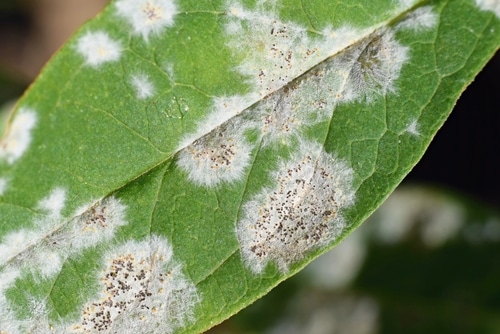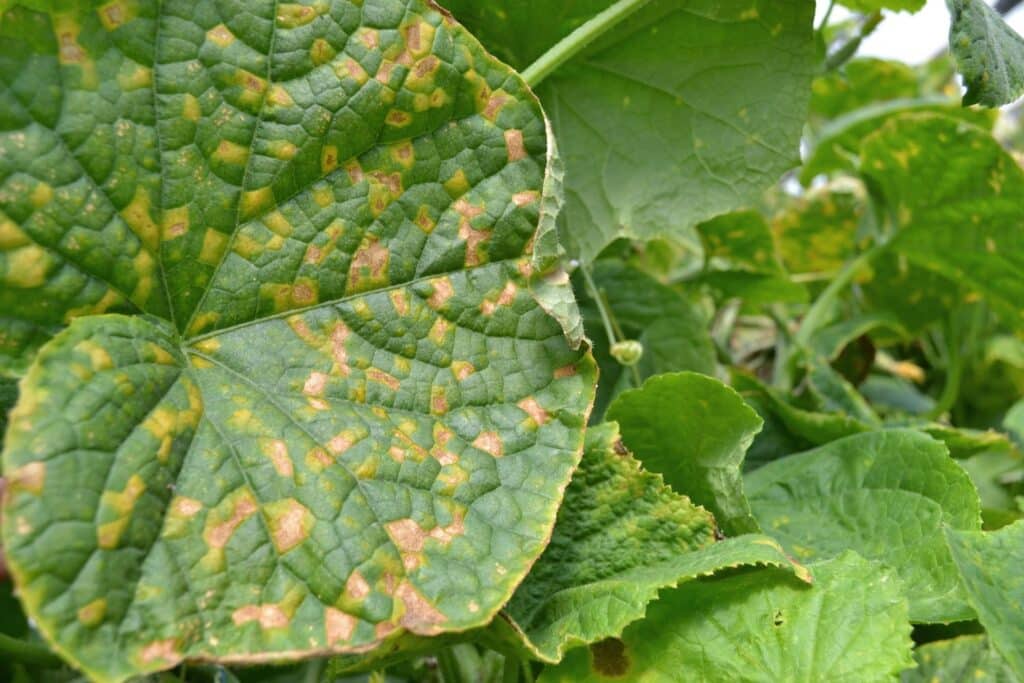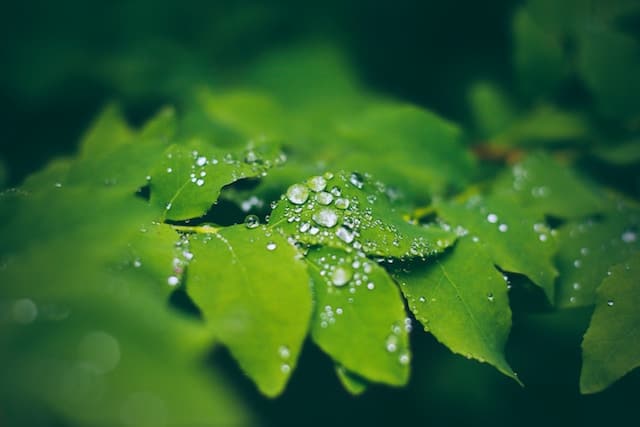Log in or create new account to save this product to your wishlist.
Fighting mildew in your garden: how to recognise and tackle it!
Mildew is a serious threat to the health of your plants and lawn. Find out how to identify it and tackle the problem before it spreads.
Latest articles
7 MIN 22 Jul How to keep your lawn in shape this summer 9 MIN 15 Jul Watering Your Garden: 10 Top Tips! 11 MIN 15 Jul Is Your Grass Type Right for your Garden? 11 MIN 10 Sep Create Your Low-Maintenance Garden – Tips and Ideas 11 MIN 08 Sep The Ultimate Guide to Choosing the Perfect Hedges for Your Garden 12 MIN 30 Aug The Top 20 Evergreen Climbers to Transform Your GardenDo you sometimes see little powdery white spots on your plant’s leaves? Maybe you see it spread across your greenhouse, or perhaps you see it develop over individual plants in your veg patch? Either way, you’re spotting mildew.
- What is mildew?
- Powdery Mildew
- Downy mildew
- How does mildew occur?
- How harmful is powdery mildew?
- Which plants are susceptible to mildew?
- How to prevent or get rid of mildew
- How to fight mildew
- How to remove fungal infections from plants
- FAQs
- Fighting mildew in your garden
Mildew is a fungal disease that can seriously damage your plants. You’ll spot it by the grey or white spots that spread across the leaves, stems, and flowers — sometimes even causing your plant to die.
This article is about identifying this particular mould that negatively impacts your plants and the measures you can take to prevent and combat this powdery mould.
Ready? Let’s get started.
What is mildew?
Mildew is a fungus that appears on plants’ leaves, stems, and flowers. You’ll recognise it as small, irregular, powdery spots that spread across the entire plant and can jump from one plant to another.
Two principal types of mildew affect veg patches and ornamental gardens: powdery and downy.
And this is how to recognise them:
Powdery Mildew

This fungus is a problem for many plants, including annuals, perennials, fruits, herbs, and vegetables. It spreads quickly and seriously damages the vitality of your plants if you fail to address the problem.
While you probably associate mould around the house with damp, powdery mildew mainly occurs during dry and hot weather. Microscopic air-borne spores spread during the growing season, landing and establishing on your plants’ surfaces, producing a powdery growth.
If you don’t tackle powdery mildew in time, the fungus darkens, causing the leaf to curl up and wither.
Unlike other fungal infections, it spreads across dry leaves — it’s not caused by extended periods of leaf wetness, making this a particular problem during dry summers.
How to recognise powdery mildew
It appears as:
- White or grey spots
- Circular patches
- Powdery in texture
The condition can cause:
- Leaf yellowing
- Stunted growth
- Flower death
So, if you spot these symptoms, take action before it’s too late. Read on to discover how to tackle powdery mildew on your plants.
Downy mildew

This is a fungal disease that presents as bright yellow or orange spots on leaves, stems, and flowers. Indeed, it’s easy to overlook downy mould as a fungal condition because it doesn’t present as typical “fuzzy mould” — many gardeners misdiagnose the problem as pest-related.
However:
Look a little closer, and you’ll spot the signs of classic fuzzy fungus on the underside of the leaf.
How to spot downy mildew
Your plants are infected with downy mould if they have:
- Light green or yellow angular spots on the upper leaf surface
- White fluffy growth on the underside of the leaf
- Overtime, the lesions go brown and dry
You’ll see downy mildew on older leaves first, but it can quickly spread to younger, healthier leaves if left untreated.
While powdery mildew thrives in dry weather, downy requires a moist environment.
How does mildew occur?

The fungus develops on or between plants — spread via spores carried on moisture droplets or through the wind, on animals and insects, and through water.
Fungus prefers a temperature of between 20 and 25℃, with a humidity of between 80 and 90%.
The problem is often exacerbated by poor air circulation between plants. So, if you’re packing your greenhouse or flowerbeds too tightly, you could create perfect conditions for this fungal infection to spread.
How harmful is powdery mildew?

The fungus can cause severe damage if you don’t tackle it quickly enough. The white mould spreads quickly, covering large areas of the plant within days.
And in some cases, the spots will cause the leaves to turn yellow, wither up, and die. And once the leaves have died, the rest of the plant is sure to follow.
Incidentally, mould can also wreak havoc on your lawn — it’s one of the most common lawn diseases after red thread, fairy rings, and rust disease. If given free rein, it sucks the moisture out of the grass blades, causing them to die and go brown or yellow.
So, tackle it quickly, even if it doesn’t appear serious at first.
Lawn doctor Louis says:
Mildew isn’t harmful to humans, but the spores can irritate the airways of some pets, such as cats and dogs.
Which plants are susceptible to mildew?

Mildew funguses can affect a wide variety of garden plants, including annuals, perennials, fruits, herbs, and vegetables.
In the ornamental garden, keep a close eye on:
- Roses
- Bergamot
- Begonias
- Honeysuckle
- Marigolds
- Zinnias
In the edible garden, look out for:
- Strawberries
- Grapes
- Cucumbers
- Pumpkins
- Tomatoes
- Courgettes
However, you can also find the mould on fruit trees, especially apple and peach. So, if you spot powdery or downy mildew, act fast to combat the disease.
How to prevent or get rid of mildew
While totally preventing the fungal infection is impossible, you can limit its impact.
Air circulation
Firstly, ensure there’s plenty of space around your plants to aid air circulation. That applies to plants in your greenhouse, flowerbed, and veg patch.
Always follow the growing guidance on seed packets (or the plant tag if you’re buying plants from a garden centre). This will tell you how much space you should leave between plants to help them thrive.
You can also trim the leaves if the vegetation becomes too dense.
Light and water
Make sure you give your plants enough light and water — this will help prevent fungal infections.
Water plants around the base of the stem or trunk, avoiding wetting the leaves, as this can promote fungal growth.
How to fight mildew
Act quick. The most common treatments are shop-bought fungicides, but there are several more natural approaches.
Natural ways to prevent plant damage from fungal growth
There are several natural ways to prevent plant damage from fungus, including:
- Neem oil — a natural antifungal agent that you can buy in squirty bottles
- Garlic — mix with water and spray it onto plant leaves and stems
- Apple cider vinegar — mix ¼ tablespoon with water for a 1-litre spray bottle, and spray onto fungus-infected leaves.
- Baking soda — mix 1 tablespoon baking soda with a litre of water and add a few drops of gentle liquid soap to help the liquid stick to the leaves.
- Milk — a surprisingly effective remedy. Mix 4 parts milk with 6 parts water, and spray the affected leaves. Repeat until the fungus has completely disappeared.
Fungicides
Fungicides are chemical solutions that kill fungal infections but use them cautiously as they can be toxic to animals and humans.
We always recommend against chemical fungicides and pesticides as much as possible. This helps maintain your garden’s delicate ecosystem. It’s always better to go with a natural alternative if there is one.
How to remove fungal infections from plants
If you’ve spotted the first signs of mildew, gently remove it with a swab of cotton wool or a soft brush. However, ensure you don’t spread the spores, so a little moisture on the cotton wool will help collect the spores.
Additionally, remove dead or dying leaves and stems to prevent the fungus from spreading to healthy parts of the plant.
Lawn doctor Louis says:
Do not throw fungus-affected plants onto your compost heap; otherwise, it will spread throughout the compost and ruin the batch. Dispose of damaged plant limbs in your unrecyclable waste bin.
FAQs
A little mildew isn’t immediately harmful to your plants, but the white mould will penetrate the plant’s cells and absorb nutrients and moisture if left to its own devices. Prevent fungal spread by leaving plenty of space between your plants, and spray a natural remedy onto the leaves if you can.
Control fungal infections with chemical fungicides or use more natural remedies such as baking soda, milk, garlic, or neem oil. Mixed with water, these store-cupboard items can help tackle mildew and stop it from spreading.
Powdery mildew develops in hot, humid weather, but it can equally occur when it’s hot and dry. It settles on and between plants via spores, which spread in the wind and within water droplets or get dispersed by animals and insects.
Fighting mildew in your garden
Remember, the most crucial thing with plant-based fungal infections is to act fast. It’s a very common problem for domestic gardeners, so use our tips to spot the first signs of fungus and tackle it.
I hope you’ve got all the information you need to help spot and combat mildew, but if you have questions, don’t hesitate to contact us.
We love hearing from you and will reply as soon as we can.
Thanks for reading, and happy gardening!
Leave a comment
Your answer will be displayed on the site and the interested party will be notified by email.
Leave a comment
Have a question or want to share your experience? Leave us a comment.
Read more
The best tips and tricks for a lush green lawn
 7 MIN
13 Sep
Lavender Cuttings: a step-by-step guide
7 MIN
13 Sep
Lavender Cuttings: a step-by-step guide
 11 MIN
10 Sep
Create Your Low-Maintenance Garden – Tips and Ideas
11 MIN
10 Sep
Create Your Low-Maintenance Garden – Tips and Ideas
 Scarifying Kit
All products after scarifying | Quickly restores the lawn after scarifying | Outsmart weeds quickly with the use of this kit
From: € 39.99
Scarifying Kit
All products after scarifying | Quickly restores the lawn after scarifying | Outsmart weeds quickly with the use of this kit
From: € 39.99
 Spring Lawn Care Kit
MOOWY’s choice for the spring | Quick recovery of your lawn after winter | A strong lawn prevents weeds
From: € 25.99
Spring Lawn Care Kit
MOOWY’s choice for the spring | Quick recovery of your lawn after winter | A strong lawn prevents weeds
From: € 25.99
 Long Lasting Lawn Fertiliser
Effective for 90 days | See results in 14 days! | Suitable for all types of grass and soil
From: € 13.99
Long Lasting Lawn Fertiliser
Effective for 90 days | See results in 14 days! | Suitable for all types of grass and soil
From: € 13.99
Do you want a lawn calendar?
🌱 All important maintenance moments for your lawn during the year. Leave your email and we will send you the lawn calendar for free.
Enter your email
Receive the lawn calendar in the mail
Enjoy a green lawn all year round!










Comments (0)
There are no comments yet. Well then, what are you waiting for to
Be the first to write your comment!inaugurate this pretty page?
Do you have some comments?